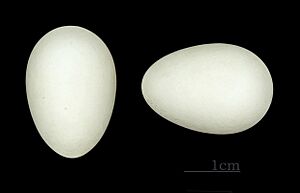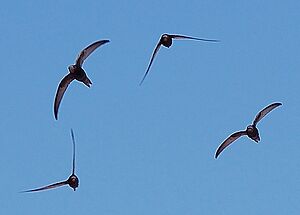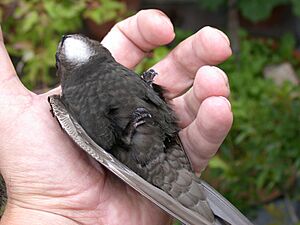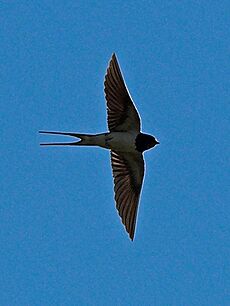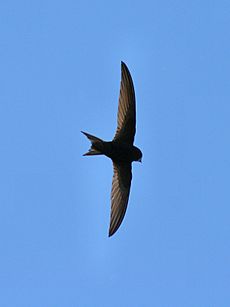Common swift facts for kids
Quick facts for kids Common swift |
|
|---|---|
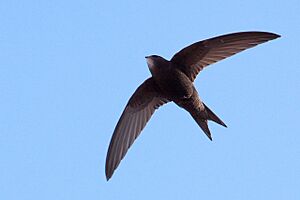 |
|
| In Barcelona, Spain | |
| Conservation status | |
| Scientific classification | |
 |
|
| Range of A. apus Breeding range Wintering range | |
| Synonyms | |
|
Hirundo apus Linnaeus, 1758 |
The common swift (Apus apus) is a medium-sized bird. It looks a bit like a barn swallow or house martin, but it's actually larger. Swifts are not closely related to swallows. They belong to a different bird group called Apodiformes. Their similar looks are just because they live in similar ways. Swifts are actually related to hummingbirds and treeswifts.
The scientific name Apus comes from Latin. It means "swift." Ancient people thought swifts were a type of swallow that had no feet. This idea came from Ancient Greek words meaning "without" and "foot."
Swifts have very short legs. They mostly use them to hold onto walls or other straight-up surfaces. This is why their German name means "wall-glider." They almost never land on the ground. On the ground, they could get hurt or caught by predators. Some swifts that aren't breeding can fly for up to ten months without landing!
Contents
What is a Common Swift?
Common swifts are about 16 to 17 centimeters (6 to 7 inches) long. Their wings can spread out 38 to 40 centimeters (15 to 16 inches). They are mostly dark brown, almost black. They have a small white or light gray patch under their chin. This patch is hard to see from far away.
Swifts have a short, forked tail. Their wings are very long and swept back. They look like a crescent moon or a boomerang when they fly.
What Does a Swift Sound Like?
Swifts make a very loud, high-pitched scream. The female's call is even higher. They often fly together in groups called "screaming parties." This happens on summer evenings. About 10 to 20 swifts fly around their nests, calling out. Other swifts in their nests call back.
Larger screaming parties happen higher in the sky. This is especially true later in the breeding season. No one is completely sure why they do this. It might be a way for them to fly up high to sleep. Or it could be a way for them to share information.
How Do Swifts Behave?
Swifts can nest in old woodpecker holes in ancient forests. For example, about 600 swifts nest in the Białowieża Forest in Poland. But most ancient forests are gone now. So, swifts have learned to nest in places made by people.
They often build their nests in buildings. They use spaces under roof tiles or window sills. They also like gaps under eaves and inside gables. Swifts build their nests from things they catch while flying. They use their saliva to stick it all together.
Swift Families
Swifts often stay with the same partner for many years. They also return to the same nesting spot each year. They fix up their nests after being away for about 40 weeks. Sometimes, insects like clothes moths eat parts of their nests.
Young swifts in the nest can survive for a few days without food. They do this by lowering their body temperature. This slows down their bodies. It's like they go into a deep sleep.
Life in the Air
Except when they are nesting, swifts spend their whole lives flying. They eat insects they catch in the air. They also drink, feed their young, and even mate while flying. Some swifts fly for 10 months without landing. No other bird spends so much of its life in the air.
Swifts can fly very fast. Their top speed is about 111.6 kilometers per hour (69 miles per hour). Over their lifetime, they can fly millions of kilometers.
Large groups of swifts gather to eat in places with lots of insects. This happens in wetlands, like near lakes or rivers. Sometimes, 2,000 swifts might gather to feed. They might fly up to 100 kilometers (60 miles) to find food.
Breeding Habits
Common swifts nest in many different places. They usually nest in buildings. But they can also use holes in trees, cliffs, and even special nestboxes. Swifts fly straight into their nesting holes. When they leave, they usually drop down first before flying off.
Swift Migration Journeys
Common swifts are migratory birds. This means they travel long distances. In summer, they breed across Europe and Asia. Their breeding range goes from Portugal to China and Siberia. They also breed in North Africa and the Middle East.
Swifts fly to Africa for the winter. They go to areas near the equator. Swifts from Sweden, for example, spend their winter in the Congo region of Africa. They spend about three to three-and-a-half months in Africa. They spend a similar time breeding. The rest of the time they are flying to or from their homes.
Younger swifts and those who didn't breed leave first. Then the breeding males leave. Finally, the breeding females leave. Females stay longer to build up their energy. Swifts often start their journey when the daylight hours get shorter. Birds in the far north leave later in August.
Migration Routes
Swifts flying through Central Europe usually go south-southwest. The Alps mountains do not stop them. If the weather is bad, they follow rivers. This is because rivers have more food. Swifts from Western Europe fly over Spain and Northwest Africa. Swifts from Russia and Southeast Europe fly over the eastern Mediterranean Sea.
The western group of swifts mostly follows the Atlantic coast of Africa. This helps them avoid crossing the Sahara Desert. Once they reach the wet grasslands, they turn southeast. This takes them to their winter feeding grounds. There are many insects in Africa during their summer. This is because of the wet season there. Swifts can almost always find food in the sky.
A few young swifts might stay in Africa. But most fly north in the spring. They use low-pressure weather systems to help them. These systems bring warm air from the southwest. On their way back, they ride northeastern winds.
In Central Europe, swifts return in late April or early May. They like to stay in low areas and near water. In northern places, they arrive later. The weather during their journey greatly affects when they arrive each year.
Swifts vs. Swallows: What's the Difference?
Barn swallows and house martins also catch insects in the air. Sometimes, you might see swifts and swallows flying together. But there are some key ways to tell them apart:
- Calls: Swifts make a loud, screaming sound. Swallows make softer, chattering noises.
- Wings: Swifts have narrow, sickle-shaped wings. Their wings are longer than their bodies. In the air, a swift looks like an anchor.
- Flight: Swifts flap their wings deeply and quickly. They also glide for longer periods. Swallows flap their wings more often. Their flight looks more fluttery.
- Color: Swifts are dark brown all over, except for the small white spot under their chin. Swallows have a light, beige-white underside. Swallows also have long, forked tails that are easy to see.
Swifts in Culture
In medieval Italy, people encouraged swifts to nest in towers and buildings. They made special holes in walls and under eaves. Young birds were sometimes eaten. But there were rules to make sure at least one young bird was left in the nest.
The "martlet" is a bird symbol used in heraldry (family crests). It is shown without feet. This symbol might have been based on the swift. It was used for the coats of arms of younger sons. This might have shown that they would travel without owning land.
See also
- International Swift Conference
- Unihemispheric slow-wave sleep




